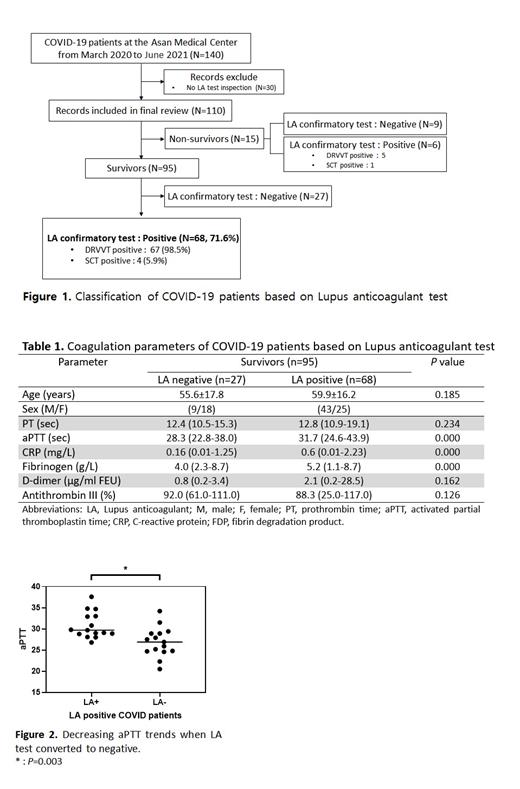Abstract
Background:Coronavirus 2019 (COVID-19) is an infectious disease caused by the severe acute respiratory syndrome coronavirus 2 (SARS-CoV-2), with severe hypercoagulable conditions and complex venous thrombosis is common. Several recent studies have reported elevated aPTT in COVID-19 patients with a thrombotic tendency, suggesting that the test results may be due to the presence of lupus anticoagulant (LA). LA, one of the antiphospholipid antibodies, is included in the diagnostic criteria for antiphospholipid syndrome (APS), and these syndromes are characterized by a tendency to thrombosis, so it is important to ascertain the meaning of LA in SARS-COV-2 infection. Here, we would like to investigate the changes in LA and the characteristics of coagulation-related factors in COVID-19 patients who have undergone LA testing.
Methods:From March 2020 to June 2021, we conducted a medical record review of clinical information and laboratory data for COVID-19 patients at our hospital. Among the 140 confirmed patients, 110 patients who underwent lupus anticoagulant testing were included in the analysis. We also performed a subgroup analysis of COVID-19 patients who were regularly screened for LA.
Results:Most of the patients in our study were mild, with 95 survivors except for the deaths of 15 patients. Lupus anticoagulant was identified in 71.6% of survivors and 40.0% of deaths. In the LA confirmatory test of survivors, DRVVT positive 98.5% and SCT positive 5.9% were found (Fig 1). When comparing coagulation parameters according to LA results in survivors, aPTT, CRP, and fibrinogen were found to be statistically significant (all P < 0.05). LA-positive patients had higher aPTT, CRP, and fibrinogen, and D-dimer was no different from LA-negative patients (Table 1). Of the 67 LA-positive patients, 25 patients did not follow up, and 12 patients were unable to clearly determine the duration of the negative transition. Among the 30 patients who underwent a follow-up LA test, short-term regular follow-up of LA testing was performed on patients from March 2021 to June 2021, and additional subgroup analysis was performed on these patients. All patients were confirmed to be DRVVT positive and had no other anti-phospholipid syndrome (APS)-related antibodies, such as anti-cardiolipin antibodies or anti-beta-2-gylcoprotein. LA disappeared rapidly within 4 weeks in all patients (range: 2-24 days). As the LA test result converted from positive to negative, aPTT decreased with a statistically significant difference (P=0.003, Fig 2).
Conclusions: As previously reported, LA was found in a high proportion of COVID-19 patients. This is the first study to confirm that the proportion of LA positivity (71.6%) is high in Korean COVID-19 patients. Most of the LA positivity disappeared within 4 weeks instead of 12 weeks. The association between LA and thrombotic tendency in COVID-19 patients appears to be low. Presumably, the transient appearance of LA, which is rapidly disappearance in survivors at a high rate, may indicate that other autoantibodies due to the activation of the immune response were detected in the LA test, can be considered as a good indicator of prognosis. It is only necessary to note that there is no delay in anticoagulant treatment due to aPTT prolongation in the early stage due to LA. In summary, the clinical significance of high LA positive rates and rapid negative transitions in COVID-19 patients is currently unknown but needs confirmation.
No relevant conflicts of interest to declare.


This feature is available to Subscribers Only
Sign In or Create an Account Close Modal